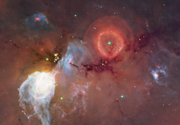 G79.29+0.46 (Spitzer Space Telescope image) | |
| Observation data Epoch J2000 Equinox J2000 | |
|---|---|
| Constellation | Cygnus |
| Right ascension | 20 31 42.2847 |
| Declination | +40° 21′ 59.0744″ |
| Apparent magnitude (V) | 15.1 |
| Characteristics | |
| Spectral type | B:I |
| Astrometry | |
| Radial velocity (Rv) | 39.02±7.30 km/s |
| Proper motion (μ) | RA: −2.925 mas/yr Dec.: −5.339 mas/yr |
| Parallax (π) | 0.5725 ± 0.0596 mas |
| Distance | approx. 5,700 ly (approx. 1,700 pc) |
| Absolute magnitude (MV) | −10 |
| Details | |
| Luminosity | 2.51×10 L☉ |
| Temperature | 20,400 K |
| Other designations | |
| GAL 079.29+00.46, GRS G079.29 +00.46, HBHA 4203-09, IRAS 20298+4011, 2MASS J20314228+4021591, WISE J203142.22+402159.0 | |
| Database references | |
| SIMBAD | data |
G79.29+0.46 is a luminous blue variable star candidate located in the Cygnus X star formation region. In the infrared and at radio wavelengths a prominent circular nebula can be seen. This nebula was formed by past mass-loss episodes of the LBV candidate.
G79.29+0.46 was first reported as a suspected LBV by Higgs, Wendker & Landecker in 1993 with the DRAO Synthesis Telescope, which identified a nebula around a star that was a wind-blown shell. As an LBV candidate, it has a spectrum with many emission lines, H-alpha being the strongest. The spectrum is similar to other LBVs and Be supergiants. The strength of the H-alpha line suggest very dense winds around this star. The star is currently losing mass at a rate of 1.4×10 M☉/year and it is surrounded by a dusty envelope with a temperature of 40 to 1,200 K. The star is considered only a candidate LBV because it has not shown variability in the optical or near-infrared over 20 years. It has been suggested that it is a LBV in the quiescent stage.
From radio and infrared images a detached shell can be seen that shows evidence of two mass-loss episodes. This shell has a mass of 1.51 M☉ and a radius of 0.66 parsecs, and it contains carbon monoxide and ammonia.
Gallery
-
 Spitzer and WISE view of G79.29+0.46, the H II-region DR15 (bright object lower left) and the IRDC G79.3+0.3 (dark clouds)
Spitzer and WISE view of G79.29+0.46, the H II-region DR15 (bright object lower left) and the IRDC G79.3+0.3 (dark clouds)
-
 The outer shell is best seen between 20 and 70 Microns, here an image by Spitzer and Herschel.
The outer shell is best seen between 20 and 70 Microns, here an image by Spitzer and Herschel.
-
 Radio image of G79.29+0.46 at 1.4 GHz
Radio image of G79.29+0.46 at 1.4 GHz
References
- ^ Gaia Collaboration (2022-05-01). "VizieR Online Data Catalog: Gaia DR3 Part 1. Main source (Gaia Collaboration, 2022)". VizieR Online Data Catalog: I/355. Bibcode:2022yCat.1355....0G. doi:10.26093/cds/vizier.1355.
- Kohoutek, L.; Wehmeyer, R. (1997). "Catalogue of stars in the Northern Milky Way having H-alpha in emission". Astronomische Abhandlungen der Hamburger Sternwarte. 11: 1. Bibcode:1997AAHam..11.....K.
- ^ Voors, R. H. M.; Geballe, T. R.; Waters, L. B. F. M.; Najarro, F.; Lamers, H. J. G. L. M. (2000-10-01). "Spectroscopy of the candidate luminous blue variable at the center of the ring nebula G79.29+0.46". Astronomy and Astrophysics. 362: 236–244. arXiv:astro-ph/0008293. Bibcode:2000A&A...362..236V. ISSN 0004-6361.
- Higgs, L. A.; Wendker, H. J.; Landecker, T. L. (1994-11-01). "G 79.29+0.46: a young stellar-wind shell in Cygnus X.". Astronomy and Astrophysics. 291: 295–309. Bibcode:1994A&A...291..295H. ISSN 0004-6361.
- ^ Agliozzo, C.; Noriega-Crespo, A.; Umana, G.; Flagey, N.; Buemi, C.; Ingallinera, A.; Trigilio, C.; Leto, P. (2014-05-01). "The candidate luminous blue variable G79.29+0.46: a comprehensive study of its ejecta through a multiwavelength analysis". Monthly Notices of the Royal Astronomical Society. 440 (2): 1391–1409. arXiv:1402.2983. Bibcode:2014MNRAS.440.1391A. doi:10.1093/mnras/stu296. ISSN 0035-8711.
- ^ Rizzo, J. R.; Palau, Aina; Jiménez-Esteban, F.; Henkel, C. (2014-04-01). "Ammonia observations in the LBV nebula G79.29+0.46. Discovery of a cold ring and some warm spots". Astronomy and Astrophysics. 564: A21. arXiv:1401.6186. Bibcode:2014A&A...564A..21R. doi:10.1051/0004-6361/201323170. ISSN 0004-6361. S2CID 119246133.
- Higgs, L. A.; Wendker, H. J.; Landecker, T. L. (1993). "Discovery of a Young Stellar-Wind Shell in Cygnus X". American Astronomical Society Meeting Abstracts. 183. Bibcode:1993AAS...183.5801H.
- Rizzo, J. R.; Jiménez-Esteban, F. M.; Ortiz, E. (2008-07-01). "Discovery of Warm and Dense Molecular Gas Surrounding the Ring Nebula G79.29+0.46". The Astrophysical Journal. 681 (1): 355–364. arXiv:0804.0266. Bibcode:2008ApJ...681..355R. doi:10.1086/588455. ISSN 0004-637X. S2CID 17847585.